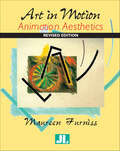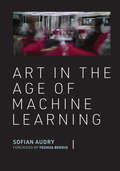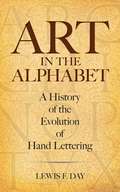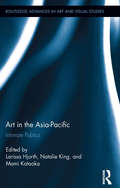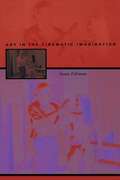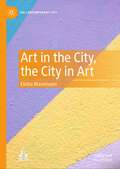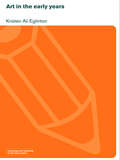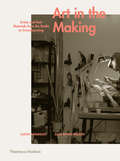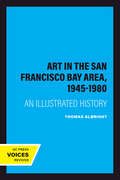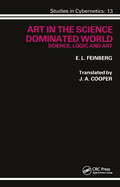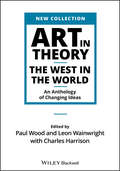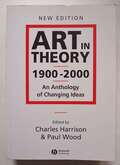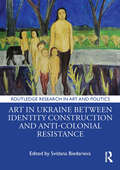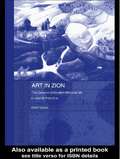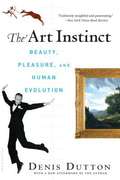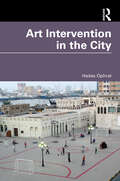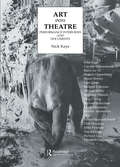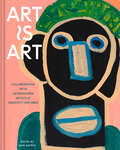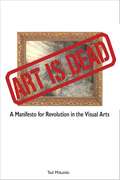- Table View
- List View
Art in Motion (Fountas & Pinnell Classroom, Guided Reading Grade 5)
by Kate DopirakA Drive to Create Many people think art is only paintings and sculptures. But what about a car? Can it be art too? Learn how some people transform plain old cars into moving works of art. NIMAC-sourced textbook
Art in Motion: Animation Aesthetics
by Maureen FurnissArt in Motion, Revised Edition is the first comprehensive examination of the aesthetics of animation in its many forms. It gives an overview of the relationship between animation studies and media studies, then focuses on specific aesthetic issues concerning flat and dimensional animation, full and limited animation, and new technologies. A series of studies on abstract animation, audiences, representation, and institutional regulators is also included.
Art in Nature (Fountas & Pinnell Classroom, Guided Reading Grade 1)
by Susan StubbsNIMAC-sourced textbook
Art in Public
by Lambert ZuidervaartThis book examines fundamental questions about funding for the arts: Why should governments provide funding for the arts? What do the arts contribute to daily life? Do artists and their publics have a social responsibility? Challenging questionable assumptions about the state, the arts, and a democratic society, Lambert Zuidervaart presents a vigorous case for government funding, based on crucial contributions the arts make to civil society. He argues that the arts contribute to democratic communication and a social economy, fostering the critical and creative dialogue that a democratic society needs. Informed by the author's experience leading a nonprofit arts organization as well as his expertise in the arts, humanities, and social sciences, this book proposes an entirely new conception of the public role of art with wide-ranging implications for education, politics, and cultural policy.
Art in Science Museums: Towards a Post-Disciplinary Approach (Routledge Research in Museum Studies)
by Camilla Rossi-Linnemann Giulia De MartiniArt in Science Museums brings together perspectives from different practitioners to reflect on the status and meaning of art programmes in science centres and museums around the world. Presenting a balanced mix of theoretical perspectives, practitioners’ reflections, and case-studies, this volume gives voice to a wide range of professionals, from traditional science centres and museums, and from institutions born with the very aim of merging art and science practices. Considering the role of art in the field of science engagement, the book questions whether the arts might help curators to convey complex messages, foster a more open and personal approach to scientific issues, become tools of inclusion, and allow for the production of totally new cultural products. The book also includes a rich collection of projects from all over the world, synthetically presenting cases that reveal very different approaches to the inclusion of art in science programmes. Art in Science Museums should be of great interest to academics, researchers and postgraduate students working in the fields of museum studies, cultural heritage management, material culture, science communication and contemporary art. It should also be essential reading for museum professionals looking to promote more reflective social science engagement in their institutions.
Art in Science Museums: Towards a Post-Disciplinary Approach (Routledge Research in Museum Studies)
by Camilla Rossi-Linnemann Giulia De MartiniArt in Science Museums brings together perspectives from different practitioners to reflect on the status and meaning of art programmes in science centres and museums around the world.Presenting a balanced mix of theoretical perspectives, practitioners’ reflections, and case-studies, this volume gives voice to a wide range of professionals, from traditional science centres and museums, and from institutions born with the very aim of merging art and science practices. Considering the role of art in the field of science engagement, the book questions whether the arts might help curators to convey complex messages, foster a more open and personal approach to scientific issues, become tools of inclusion, and allow for the production of totally new cultural products. The book also includes a rich collection of projects from all over the world, synthetically presenting cases that reveal very different approaches to the inclusion of art in science programmes.Art in Science Museums should be of great interest to academics, researchers and postgraduate students working in the fields of museum studies, cultural heritage management, material culture, science communication and contemporary art. It should also be essential reading for museum professionals looking to promote more reflective social science engagement in their institutions.
Art in the Age of Machine Learning (Leonardo)
by Sofian AudryAn examination of machine learning art and its practice in new media art and music. Over the past decade, an artistic movement has emerged that draws on machine learning as both inspiration and medium. In this book, transdisciplinary artist-researcher Sofian Audry examines artistic practices at the intersection of machine learning and new media art, providing conceptual tools and historical perspectives for new media artists, musicians, composers, writers, curators, and theorists. Audry looks at works from a broad range of practices, including new media installation, robotic art, visual art, electronic music and sound, and electronic literature, connecting machine learning art to such earlier artistic practices as cybernetics art, artificial life art, and evolutionary art. Machine learning underlies computational systems that are biologically inspired, statistically driven, agent-based networked entities that program themselves. Audry explains the fundamental design of machine learning algorithmic structures in terms accessible to the nonspecialist while framing these technologies within larger historical and conceptual spaces. Audry debunks myths about machine learning art, including the ideas that machine learning can create art without artists and that machine learning will soon bring about superhuman intelligence and creativity. Audry considers learning procedures, describing how artists hijack the training process by playing with evaluative functions; discusses trainable machines and models, explaining how different types of machine learning systems enable different kinds of artistic practices; and reviews the role of data in machine learning art, showing how artists use data as a raw material to steer learning systems and arguing that machine learning allows for novel forms of algorithmic remixes.
Art in the Alphabet: A History of the Evolution of Hand Lettering
by Lewis F. DayThis grand compilation presents more than 250 depictions of the alphabet's changing forms, from handsome Roman letters cut in marble and delicate English courthand to sixteenth-century Greek initials and modern styles inspired by Gothic, Japanese, and other forms of writing. In addition to its intriguing survey of historical trends, this book also offers richly illustrated reflections on the artistic ability involved in rendering the alphabet. An introductory essay traces the evolution of the English alphabet, followed by a wealth of old alphabets arranged in order of date. Among the selection of modern alphabets are samples that offer evidence of how the surface — wood, stone, leather, mosaic — and the writing instrument — chisel, needle, brush, stylus, pen — can affect the character of the lettering. An assortment of ampersands and numerals concludes the volume, along with an index of illustrations arranged by artist, country, material and process, and style. Artists, graphic artists, historians, and anyone with an interest in calligraphy will appreciate the historic sweep and artistic range of this treasury of lettering.
Art in the Asia-Pacific: Intimate Publics (Routledge Advances in Art and Visual Studies)
by Larissa Hjorth Natalie King Mami KataokaAs social, locative, and mobile media render the intimate public and the public intimate, this volume interrogates how this phenomenon impacts art practice and politics. Contributors bring together the worlds of art and media culture to rethink their intersections in light of participatory social media. By focusing upon the Asia-Pacific region, they seek to examine how regionalism and locality affect global circuits of culture. The book also offers a set of theoretical frameworks and methodological paradigms for thinking about contemporary art practice more generally.
Art in the Cinematic Imagination
by Susan FellemanBringing an art historical perspective to the realm of American and European film, "Art in the Cinematic Imagination" examines the ways in which films have used works of art and artists themselves as cinematic and narrative motifs.
Art in the City, the City in Art (The Contemporary City)
by Elisha MasemannThis Book examines an interplay between discourses on the city that stress the need for rational-functional order and art’s imaginative deviations from the topdown structures of urban life. Moving between theory and praxis, the book situates the city as both a concept and physical construct through which lives and possibilities are shaped or defined. In response, certain modalities of art create spontaneous, non-rational and playful interludes that risk escape from the urban apparatus and a hyper-valorisation of rational order. A three-part framework is used to discuss this push-pull dynamic and to assess the strategies of shock, performative embodiment and intervention that emerged in post-war art movements and in contemporary performance and participatory art practices. The book examines how the disturbances introduced by artists throw the city construct into sharp relief, making it visible and activating momentary encounters where new modes of expression can emerge. This Book offers a new approach to interdisciplinary studies of art and urbanity. The book aims to delineate how the city—as concept and construct—is made visible through artistic practice and in turn challenged or interrogated. Students, researchers and professionals with an interest in the interaction between art and urban studies will discover a new perspective on how urban conditions and issues have been addressed through artistic practice. The book contributes to an evolving discourse in the urban humanities through an exposition of the city’s default construct that is made visible or reimagined through visual art in public spaces.
Art in the Early Years (Teaching And Learning In The Early Years Ser.)
by Kristen Ali EglintonFor all involved in teaching young children, this timely book offers the necessary tool with which to develop a broad, creative and inspirational visual arts programme. Presented in two parts, this text covers both theoretical and practical angles: part one investigates contemporary early childhood art education, challenging what is traditionally considered an early years art experience part two puts theory to text by presenting the reader with numerous inventive visual art lessons that imaginatively meet goals for creative development issued by the QCA. The author strikes the perfect balance between discussion of the subject and provision of hands-on material for use in lessons, which makes this book a complete art education resource for all involved in early years art education. Teachers, trainee teachers, or nursery teachers, who wish to implement a more holistic art curriculum in the classroom whilst meeting all the required standards, will find this an essential companion.
Art in the Hellenistic World
by Andrew StewartWhat was Hellenistic art, and what were its contexts, aims, achievements, and impact? This textbook introduces students to these questions and offers a series of answers to them. Its twelve chapters and two "focus" sections examine Hellenistic sculpture, painting, luxury arts, and architecture. Thematically organized, spanning the three centuries from Alexander to Augustus, and ranging geographically from Italy to India and the Black Sea to Nubia, the book examines key monuments of Hellenistic art in relation to the great political, social, cultural, and intellectual issues of the time. It is illustrated with 170 photographs (mostly in color, and many never before published) and contextualized through excerpts from Hellenistic literature and inscriptions. Helpful ancillary features include maps, appendices with background on Hellenistic artists and translations of key documents, a full glossary, a timeline, brief biographies of key figures, suggestions for further reading, and bibliographical references.
Art in the Making: Artists and their Materials from the Studio to Crowdsourcing
by Glenn Adamson Julia Bryan-WilsonThe first book to address the significance of the materials and methods used to make contemporary artworks Today, artists are able to create using multiple methods of production--from painting to digital technologies to crowdsourcing--some of which would have been unheard of just a few decades ago. Yet, even as our means of making art become more extraordinary and diverse, they are almost never addressed in their specificity. While critics and viewers tend to focus on the finished products we see in museums and galleries, authors Glenn Adamson and Julia Bryan-Wilson argue that the materials and processes behind the scenes used to make artworks are also vital to current considerations of authorship and to understanding the economic and social contexts from which art emerges. This wide-ranging exploration of different methods and media in art since the 1950s includes nine chapters that focus on individual processes of making: Painting, Woodworking, Building, Performing, Tooling Up, Cashing In, Fabricating, Digitizing, and Crowdsourcing. Detailed examples are interwoven with the discussion, including visuals that reveal the intricacies of techniques and materials. Artists featured include Ai Weiwei, Alice Aycock, Isa Genzken, Los Carpinteros, Paul Pfeiffer, Doris Salcedo, Santiago Sierra, and Rachel Whiteread.
Art in the San Francisco Bay Area, 1945-1980: An Illustrated History
by Thomas AlbrightThis title is part of UC Press's Voices Revived program, which commemorates University of California Press’s mission to seek out and cultivate the brightest minds and give them voice, reach, and impact. Drawing on a backlist dating to 1893, Voices Revived makes high-quality, peer-reviewed scholarship accessible once again using print-on-demand technology. This title was originally published in 1985.This title is part of UC Press's Voices Revived program, which commemorates University of California Press’s mission to seek out and cultivate the brightest minds and give them voice, reach, and impact. Drawing on a backlist dating to 1893, Voices Revived</DIV
Art in the Science Dominated World: Science, Logic and Art
by E. L. FeinbergThe subject of cybernetics is quickly growing and there now exists a vast amount of information on all aspects of this broad-based set of disciplines. This book concerns the phenomenon of art and the special problems that arise concerning art in our era which is almost unanimously regarded as unique, as the era when science and technology have, as never before, become the influence on human society. The aim of this book is to consider the two ways of perception and cognition of the world, two kinds and trends of man’s spiritual life in their interrelation
Art in Theory: The West in the World - An Anthology of Changing Ideas
by Paul Wood Leon Wainwright Charles HarrisonArt in Theory: The West in the World is a ground-breaking anthology that comprehensively examines the relationship of Western art to the art and material culture of the wider world. Editors Paul Wood and Leon Wainwright have included over 350 texts, some of which appear in English for the first time. The anthologized texts are presented in eight chronological parts, which are then subdivided into key themes appropriate to each historical era. The majority of the texts are representations of changing ideas about the cultures of the world by European artists and intellectuals, but increasingly, as the modern period develops, and especially as colonialism is challenged, a variety of dissenting voices begin to claim their space, and a counter narrative to western hegemony develops. Over half the book is devoted to 20th and 21st century materials, though the book’s unique selling point is the way it relates the modern globalization of art to much longer cultural histories. As well as the anthologized material, Art in Theory: The West in the World contains: A general introduction discussing the scope of the collection Introductory essays to each of the eight parts, outlining the main themes in their historical contexts Individual introductions to each text, explaining how they relate to the wider theoretical and political currents of their time Intended for a wide audience, the book is essential reading for students on courses in art and art history. It will also be useful to specialists in the field of art history and readers with a general interest in the culture and politics of the modern world.
Art In Theory, 1900-2000: An Anthology Of Changing Ideas
by Charles Harrison Paul WoodThis popular anthology of twentieth-century art theoretical texts has now been expanded to take account of new research, and to include significant contributions to art theory from the 1990s. New edition of this popular anthology of twentieth-century art-theoretical texts. Now updated to include the results of new research, together with significant contributions from the 1990s. Includes writings by critics, philosophers, politicians and literary figures. The editors provide contextual introductions to 340 texts. Complements Art in Theory 1648-1815 and Art in Theory 1815-1900 to create a complete survey of the theories underpinning the development of art in the modern period.
Art in Ukraine Between Identity Construction and Anti-Colonial Resistance (Routledge Research in Art and Politics)
by Svitlana BiedarievaThis edited volume traces the development of art practices in Ukraine from the 2004 Orange Revolution, through the 2013–2014 Revolution of Dignity, to the ongoing Russian war of aggression.Contributors explore how transformations of identity, the emergence of participatory democracy, relevant changes to cultural institutions, and the realization of the necessity of decolonial release have influenced the focus and themes of contemporary art practices in Ukraine. The chapters analyze such important topics as the postcolonial retrieval of the past, the deconstruction of post-Soviet visualities, representations of violence and atrocities in the ongoing Russian war against Ukraine, and the notion of art as a mechanism of civic resistance and identity-building.The book will be of interest to scholars of art history, Eastern European studies, cultural studies, decolonial studies, and postcolonial studies.
Art in Zion: The Genesis of Modern National Art in Jewish Palestine (Routledge Jewish Studies Series)
by Dalia ManorArt in Zion deals with the link between art and national ideology and specifically between the artistic activity that emerged in Jewish Palestine in the first decades of the twentieth century and the Zionist movement. In order to examine the development of national art in Jewish Palestine, the book focuses on direct and indirect expressions of Zionist ideology in the artistic activity in the yishuv (the Jewish community in Palestine). In particular, the book explores two major phases in the early development of Jewish art in Palestine: the activity of the Bezalel School of Art and Crafts, and the emergence during the 1920s of a group of artists known as the Modernists.
The Art Instinct: Beauty, Pleasure, & Human Evolution
by Denis DuttonThe Art Instinct combines two of the most fascinating and contentious disciplines, art and evolutionary science, in a provocative new work that will revolutionize the way art itself is perceived. Aesthetic taste, argues Denis Dutton, is an evolutionary trait, and is shaped by natural selection. It's not, as almost all contemporary art criticism and academic theory would have it, "socially constructed.
Art Intervention in the City
by Hadas OphratThis book focuses on the phenomenon of art intervention—an expression of local initiatives by artists, collectives, and art centers wishing to influence the design of the space or make a change in its lifestyle. It pertains not only to acts of protest, but also to the creation of a new civil and political situation in which artists acknowledge their ability to constitute foci of power. These are reflected in acts such as squatting in abandoned buildings, restoring and redistributing them according to principles of social justice; mapping the city based on alternative parameters, such as revealing venues of collective memory or exposing the city's backyard; creating outdoor urban art galleries; and creating temporary architecture and alternative solutions in order to deal with the challenges we face in times of epidemic and environmental crisis. The art intervention phenomenon has intensified since the mid-1990s, so much so that even local authorities the world over have begun to adopt activist and artistic practices. Due to the intensive urbanization processes and current global threats, the creative trends and means surveyed in the book are crucial. This book will interest researchers, planners, urban planners, architects, social activists, local authority executives, art centers, artists, and designers.
Art Into Theatre: Performance Interviews and Documents (Contemporary Theatre Studies #Vol. 16.)
by Nick KayeArt Into Theatre investigates the processes of hybrid forms of performance developed between 1952 and 1994 through a series of interviews with key practitioners and over 80 pieces of documentation, many previously unpublished, of the works under discussion.Ranging from the austerity of Cage's 4'33" through the inter-species communication of Schneeman's Cat Scanand the experimental theatre work of Schechner, Foreman, and Kirby, to the recent performances of Abramovic, Forced Entertainment and the Wooster Group, Art Into Theatre offers a fascinating collection of perspectives on the destabilizing of conventional ideas of the art "object" and the theatrical "text". Nick Kaye's introductory essay to the volume offers a useful context for the reader and each interview is preceded by an informative biographical sketch.
Art Is Art: 40 Years of Collaborating with Neurodiverse Artists at Creativity Explored
by Ann KappesCreativity Explored celebrates its 40th anniversary with a collection of powerful artwork and perspectives from its talented studio artists.This vibrant book uplifts the voices of the artists of Creativity Explored, a nonprofit that gives people with developmental disabilities the opportunity to express themselves through art and share their work with audiences from their local community and in the contemporary art world.This curated collection features more than one hundred original paintings, drawings, illustrations, and sculptures—as well as quotes and stories from the artists—inviting readers to examine and challenge their perceptions about disability. Some artworks are humorous and blunt, while others are affecting and abstract, speaking to the artistic community's diversity and creativity. This book offers an engaging introduction to person-centered thinking for art lovers or anyone interested in learning about disability justice in a visual way.DEMYSTIFYING DISABILITY: This significant new anthology showcases an array of developmentally disabled artists and organizes their works into thematic chapters, such as "Self Medication," "On the Spectrum," "Yes I Do Think About Sex," and "Our Fears." These chapters provide interesting stylistic juxtapositions and personal reflections that highlight both individual and shared experiences as diverse disabled artists. BEAUTIFUL AND CONTENT RICH: This gorgeous hardcover art book features more than one hundred original artworks in full color, from lively portraits and detailed drawings to abstract paintings and captivating illustrations. Quotes, interviews, personal stories, and artist statements also give readers deeper insight into the artists' creative practices, processes, and rituals. This book is a rich visual trove and source of inspiration for any contemporary art lover. SUPPORT A GREAT CAUSE: Creativity Explored was founded in 1983 with the belief that art is essential to life. This book celebrates the organization's mission and its talented artists after forty years of creating impactful arts and career programs with developmentally disabled artists. This collection is a meaningful way to learn more about Creativity Explored and the diverse community it continues to support today.Perfect for:Art lovers and activistsPeople who admire the mission and work of Creativity ExploredThe disabled community, allies, and educatorsGift seekers for family and friends interested in learning more about disability justiceFans of self-taught artists, folk arts, and "outsider art"Contemporary art anthology and art book collectors#OwnVoices readers and anyone interested in diversifying their contemporary art knowledge
Art Is Dead: A Manifesto for Revolution in the Visual Arts
by Ted MikulskiIf you were asked to name your favorite living visual artist what would you say? Unfortunately, the average American does not have an answer to that question, nor can they rationalize a piece of art beyond the Mona Lisa. Intriguing and entertaining, Art is Dead takes a profound look at visual art in America through the eyes of artist and art professor Ted Mikulski. This book steps outside of the conventional art bubble and rationalizes how we in America perceive both art and the artists creating it. Art Is Dead takes a stab at the question, why don?t Americans know more about art? Drawing on interviews with artists, gallery owners, curators, and those not involved in the art world, Mikulski takes the reader on a journey into visual arts current status in society. Artists will always be around, but are they revered? Are they appreciated? And more importantly, are they figureheads in society?

